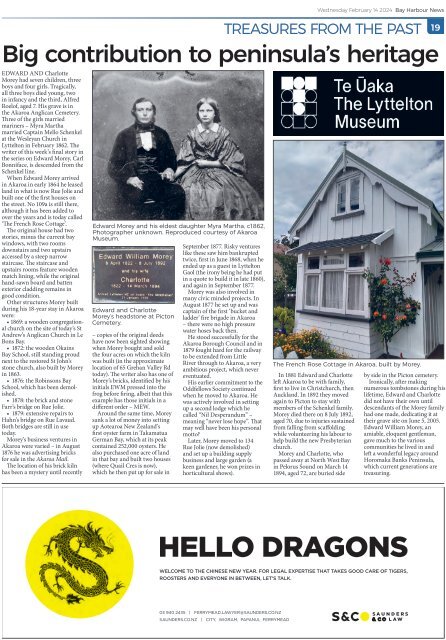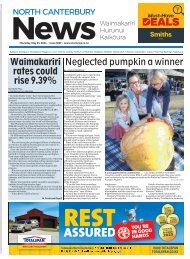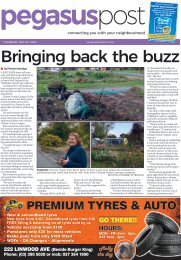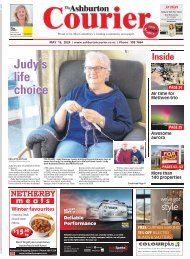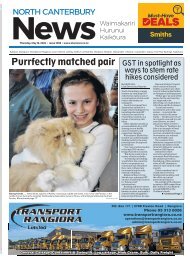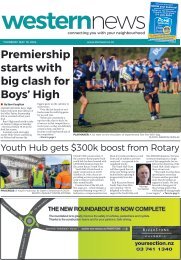Bay Harbour: February 14, 2024
Create successful ePaper yourself
Turn your PDF publications into a flip-book with our unique Google optimized e-Paper software.
Wednesday <strong>February</strong> <strong>14</strong> <strong>2024</strong> <strong>Bay</strong> <strong>Harbour</strong> News<br />
TREASURES FROM THE PAST 19<br />
Big contribution to peninsula’s heritage<br />
EDWARD AND Charlotte<br />
Morey had seven children, three<br />
boys and four girls. Tragically,<br />
all three boys died young, two<br />
in infancy and the third, Alfred<br />
Roelof, aged 7. His grave is in<br />
the Akaroa Anglican Cemetery.<br />
Three of the girls married<br />
mariners – Myra Martha<br />
married Captain Mello Schenkel<br />
at the Wesleyan Church in<br />
Lyttelton in <strong>February</strong> 1862. The<br />
writer of this week’s final story in<br />
the series on Edward Morey, Carl<br />
Bonniface, is descended from the<br />
Schenkel line.<br />
When Edward Morey arrived<br />
in Akaroa in early 1864 he leased<br />
land in what is now Rue Jolie and<br />
built one of the first houses on<br />
the street. No 109a is still there,<br />
although it has been added to<br />
over the years and is today called<br />
‘The French Rose Cottage’.<br />
The original house had two<br />
stories, minus the current bay<br />
windows, with two rooms<br />
downstairs and two upstairs<br />
accessed by a steep narrow<br />
staircase. The staircase and<br />
upstairs rooms feature wooden<br />
match lining, while the original<br />
hand-sawn board and batten<br />
exterior cladding remains in<br />
good condition.<br />
Other structures Morey built<br />
during his 18-year stay in Akaroa<br />
were:<br />
• 1869: a wooden congregational<br />
church on the site of today’s St<br />
Andrew’s Anglican Church in Le<br />
Bons <strong>Bay</strong>.<br />
• 1872: the wooden Okains<br />
<strong>Bay</strong> School, still standing proud<br />
next to the restored St John’s<br />
stone church, also built by Morey<br />
in 1863.<br />
• 1876: the Robinsons <strong>Bay</strong><br />
School, which has been demolished.<br />
• 1878: the brick and stone<br />
Farr’s bridge on Rue Jolie.<br />
• 1879: extensive repairs to<br />
Hahn’s bridge on Rue Lavaud.<br />
Both bridges are still in use<br />
today.<br />
Morey’s business ventures in<br />
Akaroa were varied – in August<br />
1876 he was advertising bricks<br />
for sale in the Akaroa Mail.<br />
The location of his brick kiln<br />
has been a mystery until recently<br />
Edward Morey and his eldest daughter Myra Martha, c1862,<br />
Photographer unknown. Reproduced courtesy of Akaroa<br />
Museum.<br />
Edward and Charlotte<br />
Morey’s headstone at Picton<br />
Cemetery.<br />
– copies of the original deeds<br />
have now been sighted showing<br />
when Morey bought and sold<br />
the four acres on which the kiln<br />
was built (in the approximate<br />
location of 65 Grehan Valley Rd<br />
today). The writer also has one of<br />
Morey’s bricks, identified by his<br />
initials EWM pressed into the<br />
frog before firing, albeit that this<br />
example has those initials in a<br />
different order – MEW.<br />
Around the same time, Morey<br />
sank a lot of money into setting<br />
up Aotearoa New Zealand’s<br />
first oyster farm in Takamatua<br />
German <strong>Bay</strong>, which at its peak<br />
contained 252,000 oysters. He<br />
also purchased one acre of land<br />
in that bay and built two houses<br />
(where Quail Cres is now),<br />
which he then put up for sale in<br />
September 1877. Risky ventures<br />
like these saw him bankrupted<br />
twice, first in June 1868, when he<br />
ended up as a guest in Lyttelton<br />
Gaol (the irony being he had put<br />
in a quote to build it in late 1860),<br />
and again in September 1877.<br />
Morey was also involved in<br />
many civic minded projects. In<br />
August 1877 he set up and was<br />
captain of the first ‘bucket and<br />
ladder’ fire brigade in Akaroa<br />
– there were no high pressure<br />
water hoses back then.<br />
He stood successfully for the<br />
Akaroa Borough Council and in<br />
1879 fought hard for the railway<br />
to be extended from Little<br />
River through to Akaroa, a very<br />
ambitious project, which never<br />
eventuated.<br />
His earlier commitment to the<br />
Oddfellows Society continued<br />
when he moved to Akaroa. He<br />
was actively involved in setting<br />
up a second lodge which he<br />
called “Nil Desperandum” –<br />
meaning “never lose hope”. That<br />
may well have been his personal<br />
motto?<br />
Later, Morey moved to 134<br />
Rue Jolie (now demolished)<br />
and set up a building supply<br />
business and large garden (a<br />
keen gardener, he won prizes in<br />
horticultural shows).<br />
The French Rose Cottage in Akaroa, built by Morey.<br />
In 1881 Edward and Charlotte<br />
left Akaroa to be with family,<br />
first to live in Christchurch, then<br />
Auckland. In 1892 they moved<br />
again to Picton to stay with<br />
members of the Schenkel family.<br />
Morey died there on 8 July 1892,<br />
aged 70, due to injuries sustained<br />
from falling from scaffolding<br />
while volunteering his labour to<br />
help build the new Presbyterian<br />
church.<br />
Morey and Charlotte, who<br />
passed away at North West <strong>Bay</strong><br />
in Pelorus Sound on March <strong>14</strong><br />
1894, aged 72, are buried side<br />
by side in the Picton cemetery.<br />
Ironically, after making<br />
numerous tombstones during his<br />
lifetime, Edward and Charlotte<br />
did not have their own until<br />
descendants of the Morey family<br />
had one made, dedicating it at<br />
their grave site on June 5, 2005.<br />
Edward William Morey, an<br />
amiable, eloquent gentleman,<br />
gave much to the various<br />
communities he lived in and<br />
left a wonderful legacy around<br />
Horomaka Banks Peninsula,<br />
which current generations are<br />
treasuring.<br />
HELLO DRAGONS<br />
WELCOME TO THE CHINESE NEW YEAR. FOR LEGAL EXPERTISE THAT TAKES GOOD CARE OF TIGERS,<br />
ROOSTERS AND EVERYONE IN BETWEEN, LET’S TALK.<br />
03 940 2435 | FERRYMEAD.LAWYER@SAUNDERS.CO.NZ<br />
SAUNDERS.CO.NZ | CITY, WIGRAM, PAPANUI, FERRYMEAD


